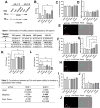Decoding a novel non-enzymatic protein acetylation mechanism in sperm that is essential for fertilizing potential
- PMID: 40442844
- PMCID: PMC12121157
- DOI: 10.1186/s40659-025-00613-6
Decoding a novel non-enzymatic protein acetylation mechanism in sperm that is essential for fertilizing potential
Abstract
Background: Protein acetylation has emerged as essential for sperm function, attracting considerable attention recently. Acetylation, typically mediated by lysine acetyltransferases, involves attaching an acetyl group from acetyl-coenzyme A to lysine residues in proteins. Under alkaline conditions, however, acetylation can occur with minimal enzymatic involvement, primarily due to an elevated pH. As sperm migrate towards the ampulla, they experience increasing intracellular pH (pHi) while undergoing two crucial processes for fertilization: capacitation and the acrosome reaction (AR). Whereas the involvement of acetylating enzymes in these events has been partially investigated, the potential for non-enzymatic acetylation driven by the pHi alkalinization remains unknown.
Results: This study examined protein acetylation (acLys) levels in sperm incubated under capacitating conditions at pH 7.2 and pH 9.0, the latter condition potentially promoting non-enzymatic acetylation. To more precisely investigate the occurrence of non-enzymatic acetylation events, acetyltransferase activity was selectively attenuated using a specific cocktail of inhibitors. The functional implications of these conditions were assessed by examining key fertilization-related sperm attributes, including motility during capacitation and the ability to initiate the AR. Results demonstrated that alkaline conditions elevated basal acLys levels even with reduced acetyltransferase activity (P < 0.05), indicative of non-enzymatic acetylation. α-tubulin, particularly in the midpiece of the sperm flagellum, was identified as a specific target of this modification, correlating with diminished motility during capacitation. Following the AR, acLys levels in the head and midpiece decreased (P < 0.05) under conditions promoting non-enzymatic acetylation, accompanied by reductions in intracellular and acrosomal pH. In contrast, acLys levels and pH in the sperm head incubated under standard capacitating conditions (pH 7.2) remained stable. Sperm exposed to conditions conducive to non-enzymatic acetylation exhibited an impaired ability to trigger the AR (P < 0.05) compared to those maintained at pH 7.2. Notably, diminished acetylase activity emerged as a key factor impairing the maintenance of intracellular and acrosomal pH levels attained during capacitation, even under a pH of 9.0.
Conclusion: This study provides novel evidence for the occurrence of non-enzymatic acetylation in sperm, linked to the modulation of α-tubulin acetylation levels and motility during capacitation. Additionally, it suggests that acetyltransferase activity may play a crucial role in regulating intracellular and acrosomal pH levels in capacitated sperm, facilitating the AR.
Keywords: Acrosome reaction; Motility; Non-enzymatic acetylation; Sperm capacitation; pH; α-tubulin.
© 2025. The Author(s).
Conflict of interest statement
Declarations. Ethics approval and consent to participate: Not applicable. Consent for publication: Not applicable. Competing interests: The authors have no conflict of interest to declare.
Figures




References
-
- Le-Tian Z, Cheng-Zhang H, Xuan Z, Zhang Q, Zhen-Gui Y, Qing-Qing W, Sheng-Xuan W, Zhong-Jin X, Ran-Ran L, Ting-Jun L, Zhong-Qu S, Zhong-Hua W, Ke-Rong S. Protein acetylation in mitochondria plays critical functions in the pathogenesis of fatty liver disease. BMC Genom. 2020;21(1):1–17. 10.1186/s12864-020-06837-y. - PMC - PubMed
-
- Paik WK, Pearson D, Lee HW, Kim S. Nonenzymatic acetylation of histones with acetyl-CoA. BBA Sect Nucl Acids Protein Synth. 1970;213(2):513–22. 10.1016/0005-2787(70)90058-4. - PubMed
MeSH terms
Grants and funding
LinkOut - more resources
Full Text Sources
Research Materials

